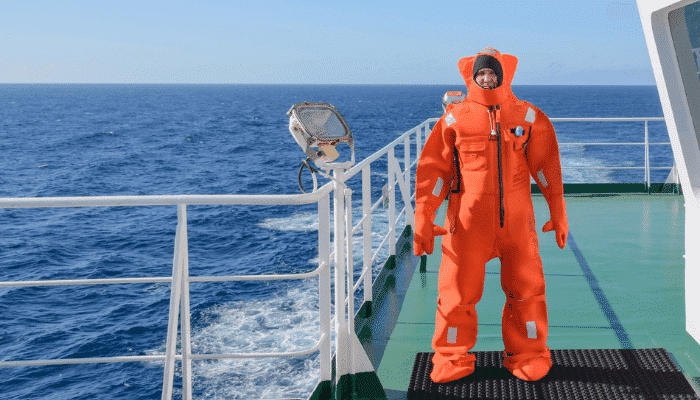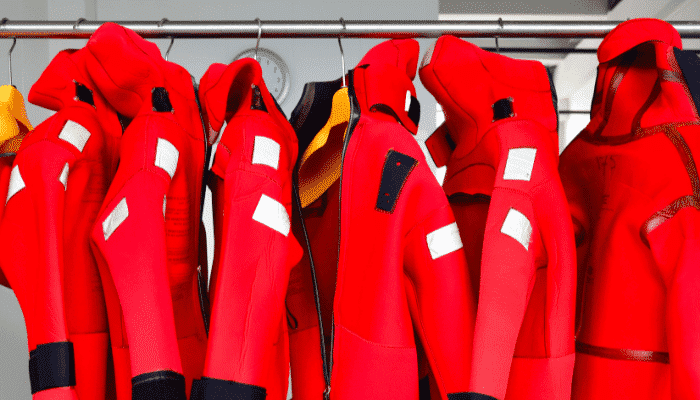

An immersion suit is a body covering suit worn specifically for flotation and survival during emergencies on high seas. This suit is, therefore, also known as a survival or rescue suit, used during commercial operations. In today’s times, an immersion suit is one of the necessities on ships and oil rigs, considering the protection needed from cold water, rough seas and dangerous situations.
Hence, all sailors, commercial fishermen, and crew members onboard cargo vessels maintain their immersion suits, which offer better visibility and prevent them from drowning. It also provides hypothermia protection and saves from extremities as it is made of waterproof material. Some suits have harnesses and offer ankle adjustments or a better fit.
Immersion suits are generally made of neoprene, a type of rubber that is completely waterproof and can withstand extreme temperatures of water and fire. The immersion suit fits the person’s body without exposing any part to the water. It also has a protective hood to cover the head and comes along with protective gloves. Hence, it provides warmth to the body while its inflatable head pillow and air bladders increase buoyancy.
Maintenance of immersion suits is a must. Regular inspections should be done, and suits must be checked thoroughly for any holes, tears etc. Their inflatable hoses, zipper, straps, mitts and face shield should also be checked. If they had been in salt water, they should have been rinsed with fresh water and left to dry, but not in direct sunlight.
A rescue suit is designed mainly in two colours – red and orange. Both the colours are kept bright (fluorescent) so that the suits can immediately attract the attention of paramedics or rescue aid.


The following are the SOLAS Regulations for Immersion Suits; to know how many immersion suits are present onboard a ship, one should refer to the “fire control and safety plan“:
There are three types of immersion suits. The main types can be described as follows:
Particular immersion suits are also inbuilt with an emergency torch, a whistle and a tagline that can be attached to the case of the person who is being rescued. This tagline, also known as the buddy line, is provided to ensure that everyone is together and no person gets lost while in the water.
The technology in creating and developing an immersion suit has come a long way. In the days to come, even more advancements will continue to make the application more successful than it is.


To know the number and location of the anti-exposure suits, refer to the “fire control and safety plan.”
Check the “fire control and safety plan” for the number and location of the TPAs.
The third mate must ensure regular checks are carried out on this imperative equipment to function as needed under unfortunate circumstances.
An immersion suit covers the entire body and is worn by mariners, sailors and commercial fishermen to remain afloat during seas emergencies. Hence, it is also known as a survival suit or rescue suit.
According to SOLAS/LSA provisions, the immersion suit should meet the given safety and performance requirements, including no more than two minutes of donning time, impact protection of up to 4.5 m and hypothermia protection for 6 hours.
Immersion suits are of two kinds, work suits worn by personnel on high seas for longer periods and survival suits worn during times of emergency.
Immersion suits are essential safety equipment and should be maintained well. An immersion suit over ten years of age should be serviced annually at an authorised service station.
No, we do not need a life jacket inside an immersion suit. It is designed to be worn without a lifejacket and has a light and whistle, complying with the requirements of life jackets.
You may also like to read:
Disclaimer: The authors’ views expressed in this article do not necessarily reflect the views of The Marine Learners. Data and charts, if used, in the article have been sourced from available information and have not been authenticated by any statutory authority. The author and The Marine Learners do not claim it to be accurate nor accept any responsibility for the same. The views constitute only the opinions and do not constitute any guidelines or recommendations on any course of action to be followed by the reader.
The article or images cannot be reproduced, copied, shared or used in any form without the permission of the author and The Marine Learners.










We believe that knowledge is power, and we’re committed to empowering our readers with the information and resources they need to succeed in the merchant navy industry.
Whether you’re looking for advice on career planning, news and analysis, or just want to connect with other aspiring merchant navy applicants, The Marine Learners is the place to be.